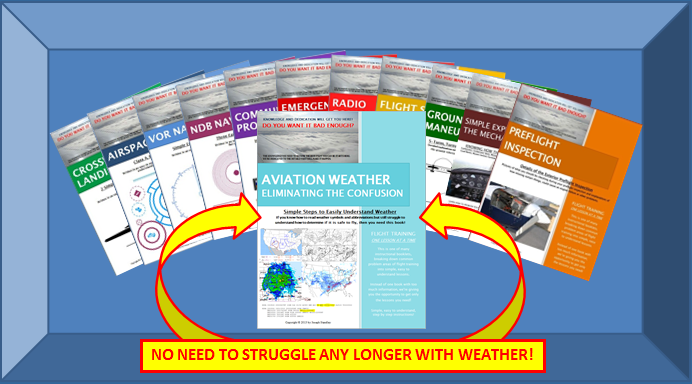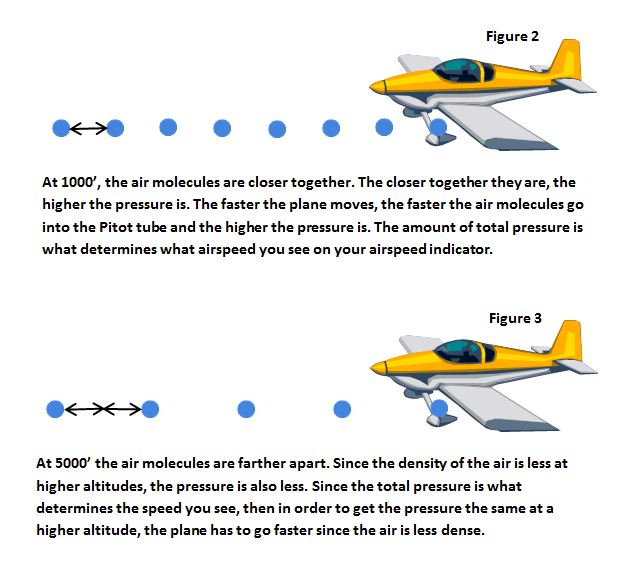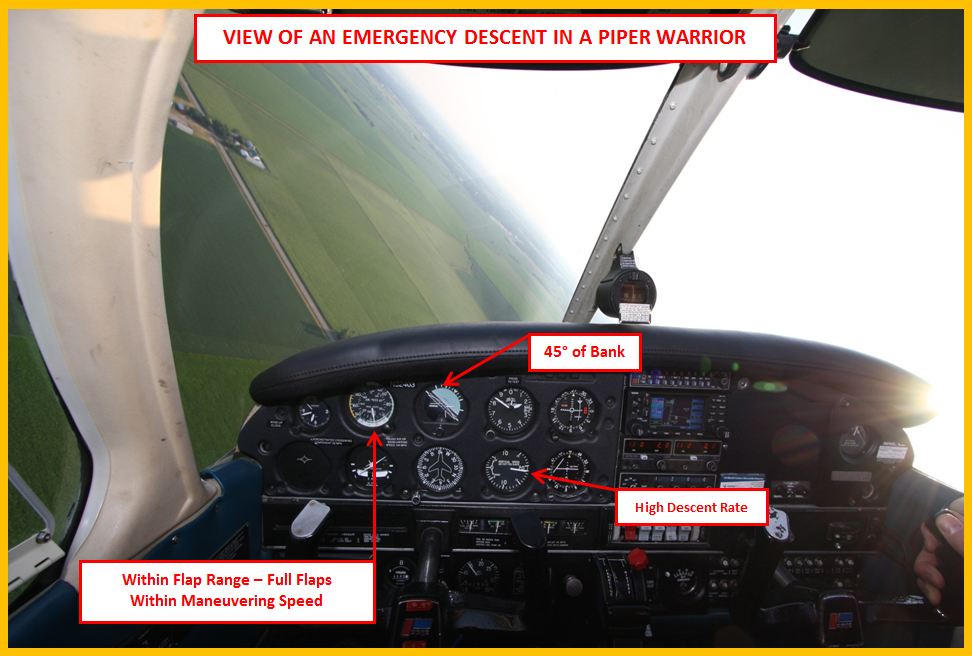by Joseph Standley | Jul 6, 2012 | Student Pilots

These E-Lessons are written in an easy to understand format, avoiding all the technical language that just confuses people. Simple, step by step instructions walk you through every step to be sure that you understand, once and for all. For the price of about 10 minutes with an instructor, you can get just the lesson you need. Why buy a whole book when you’re only struggling with one or two areas?
We have many more to come! Feel free to send us an email with areas you’d like to see covered. Click image for more details about what each lesson covers. Fly safe and never stop learning!
by Joseph Standley | Jul 4, 2012 | All Pilots
When you hear the term “high density altitude”, do you get confused as to what that means? Most people do, so don’t worry! We’re going to clear it up once and for all and talk about how it affects you. Before we start, I’d like to clarify something. The images below are not to scale nor do they represent how close the molecules are to each other or the way they are laid out exactly in relation to the earth or each other. They are positioned this way for you to easily visualize how the density of the air changes with altitude and to better understand how it affects performance. It does not talk about how the air is compressed and becomes more dense, it simply shows that the air is less dense as you go higher.
When you hear “high density altitude”, it does NOT mean that the air is dense (thick) like most people think. You can’t just look at the words “high and density”, that of course would mean the air is dense. You need to look at the whole thing. When you hear the words “high density altitude”, it’s referring to the density of the air at a higher altitude.
For example, your home town airport has an elevation of 1000′ above sea level. You tune in the automated weather station and you hear it say that the density altitude is 3000′. That is a high density altitude because it’s higher than the field elevation at your airport. It is saying that the density (amount or thickness) of the air at your airport is equal to what it would be at 3000′. I will explain more in a minute with a diagram.
So what does the air density do as you go higher? If you don’t remember, think of going so high that you are in space. What is the density of the air there? The air density is much less. To make that even easier to understand, don’t think of all the empty space around you as air. Think of air as a bunch of balls (molecules). The amount of balls (molecules) there are determines the density of the air (molecules). If I fill a box with the balls (air molecules), it is dense with air. If I take a box that is twice the size and dump the balls from the smaller box into it, I have the same amount of balls (air molecules) in it but since they are not filling the box now, it is no longer dense with air.
This is the same concept you need to think of as you fly higher. People think that as you go higher, there is less air. That is not true. Think of the box scenario. As you go higher, you still have the same amount of air, but the air isn’t as dense (tightly packed together). Look at the diagram below and notice how there is the same amount of air molecules at a higher altitude, but they are farther apart from each other.
 Notice how as you go higher, the air is less dense (packed together), but the same amount of air molecules is still there. So how does this affect you? The airplane needs air to fly. When you’re taking off, you have to get to the right speed before there is enough air (molecules of air) traveling over and under the wing to support lift.
Notice how as you go higher, the air is less dense (packed together), but the same amount of air molecules is still there. So how does this affect you? The airplane needs air to fly. When you’re taking off, you have to get to the right speed before there is enough air (molecules of air) traveling over and under the wing to support lift.
The airspeed works the same way. As you accelerate down the runway, the balls (air molecules) are going into the pitot tube faster and faster and the pressure is increasing. The total pressure is what gives you your airspeed reading. Look at figures 2 and 3 below and to see how the density of the air at different altitudes affects performance.

So, let’s look at the above example in a take off situation. In figure 2 above, lets assume that our field elevation is 1000′. When the balls (air molecules) start entering the pitot tube and the pressure increases enough to indicate whatever your lift off speed is, then you’re ready to fly.
In figure 3 above, your field elevation is 5000′. Since we know the air is less dense (air molecules are farther apart) at higher altitudes, we know that we have a farther distance to travel to get to the next molecule of air. If we have farther to travel but we need the same amount of pressure to give us the required lift off speed, then we will have to go faster to do so. To go faster takes more time. More time traveling means more runway being used. This is the reason it takes more runway distance to take off at a high elevation airport. The same applies for landing. To keep the speed indicating properly when landing at a high elevation airport, you need to be traveling faster. Even though the speed is indicating the same, you will be flying much faster over the ground and using up more runway in the process.
The last part of this article, is heat. Heat affects the plane the same way high altitude does. As it gets hotter outside, the air becomes less dense. As the air becomes less dense, the plane will use more runway to get to flying speed just as if it were at a high elevation airport. When you hear the automated weather say that the density altitude is at 5000′ for example, that means your plane will perform as if you were flying at an elevation of 5000′.
High density altitude, high airport elevation and heat all mean more runway, slower acceleration and and worse performance. Always be sure to check your performance chart so you know how much runway and what kind of climb rate you will get before taking off. You want to be sure the runway is long enough and that you will clear the obstacles at the end! Sign up for our free newsletter for more information about how this can affect you and for other tips, advice and recommendations sent to your email.
by Joseph Standley | Jun 26, 2012 | All Pilots

Today I heard of an accident near my home airport. There was a guy that contacted approach control and said that his plane was on fire and that he was going to try to make it to the airport. The airport was from what I understand was 8 miles away. He was going to try to fly 8 miles while on fire! He didn’t make it.
If you’re ever on fire, get down NOW and put the plane on the ground as quckly as possible! The PTS requires that a pilot demonstrate an emergency descent, which would have been this guys best option. It used to be that just commercial pilots had to demonstrate these but as of recently, you have to do it as a private too.
As you know, when you have an engine failure, you pitch and hold best glide speed while looking for a field. You are usually in the air for quite awhile and have a lot of time to figure things out. The difference between a normal engine failure landing setup and an emergency descent is that the emergency descent requires immediate reaction and a descent as fast as possible. A perfect example would be if your plane was on fire.
If your plane is burning, you have very limited time to get down. In a matter of 5 minutes, you’re whole plane could be engulfed in flames. There’s no time for best glide speed or choosing the perfect field. The first thing you need to do is cut off the fuel. Yes, that means you will be shutting off your engine. The alternative is to continue pumping fuel into the fire. Now to get down quickly, you don’t want to just push the nose forward because you will build up excess airspeed which will be hard to bleed off when trying to land.
The way that works the best is to put in full flaps (as long as you’re in the flap operating range) and start a descending turn using 45° of bank. You want to pitch forward enough to keep it in the white arc. Keep the speed near the top of the white arc but not quite on the edge of it. This should give you around a 2000′ per minute descent rate (in a Warrior), just keep pitching to hold the best descent rate within the capability of the plane you fly while keeping it in the white arc.
While you are turning, look at the fields directly around and below you and plan your roll out as you get close. Your control inputs should be gentle so that you don’t have any sudden movements which could damage the plane. By the time you roll out and pitch back up to a more normal attitude for landing, the slower descent airspeed, plus the drag of the flaps will slow you down quickly to a normal landing speed.
On your way down you should definately turn off the heater or any vents that are open between you and the engine compartment to slow or stop the fire or smoke from entering the cabin. Flying the plane is always number one, but if time and altitude permit, grab the checklist to be sure you’ve done everything you can. Again, this is only if you have the time. Concentrating on getting the plane down safely and getting out as fast as possible is the real goal.
Never try to make an airport that is far away while on fire. It’s not worth your life. Fire can heat metal to a melting point. Even if it never gets to its melting point, it will weaken it. Strucural failure could happen before you make it to the ground, so don’t mess around with it. Once it makes it to the cabin, now you have to worry whether you are going to make it. If you’ve never done an emergency descent, get with an instructor and learn it, because it could save your life one day!
by Joseph Standley | Jun 25, 2012 | Student Pilots
Setting up the plane for it’s final descent and approach speed is actually pretty simple. Many instructors give students various different speeds for the different legs in the pattern, with each speed being less as they get close to final. I don’t teach this method because I feel that it gives the student more to think about.
Next time you are on downwind, look at the horizon and with your best estimate, guess how many inches the top of the instrument panel is below the horizon. Depending on how high you are sitting in the seat and what your power setting is, it may vary somehwere from 1″ – 3″. For this example we will assume that the top of the panel is 2″ below the horizon in level flight on downwind.
With that number in mind, when it’s time to throttle back, all you have to do is lower the nose about 1″. So if you were flying with the instrument panel 2″ below the horizon, you will now have it 3″ below the horizon. If you hold that pitch angle accurately the whole time, even while turning, the plane will slow down to the correct airspeed all by itself as you add flaps. You have to adjust your throttle as needed for altitude. Typically for a small 4 seat plane, the power will be 1500 – 1600 rpm.
An example in a Warrior would be 2300rpm on downwind. Just before I get even with the numbers on the runway, I power back to 1600rpm, drop the nose 1″ lower and put it a flap at the same time. Don’t allow the plane to go up when you put in the flap! Just before I turn base, I put in the next flap. Keep it trimmed in that nose low attitude after each addition of flaps. Just before turning final, I put in the last flap. If your speed is increasing while descending instead of decreasing, then your nose it a little too low. If you’re descending 1000′ per minute, then your nose is also too low. Many people end up raising the nose during the turn so be careful not to let that happen.
If you hold this position all the way around, then you will get a gradual decrease in speed while adding flaps, and end up at your final approach speed by the time you turn final. The altitude should be close too but you need to keep an eye on it and make small adjustments as needed with your throttle to maintain a good glide path. This method works great. I’m not sure how it will transfer to you in written form without a demo, but if you’re having problems controlling your speed and altitude when landing, it would be worth trying. Put the plane where it should be and everything will fall into place by itself. Have fun!
by Joseph Standley | Jun 25, 2012 | Pilots
You’ve worked hard and long to build up the experience you needed to get your instrument rating. You learned how to control the plane better, understand airspace and communication better and learned a whole new set of aviation terms. You should definately feel good about yourself for the hard work you put into it to accomplish that goal. The problem is that many instrument pilots forgot where they came from and what it was like to be a VFR only pilot.
So, what am I referring to? I’m talking about your new found IFR language! It’s great to know it and it’s fun to use it, but there is a time for it. Let me explain in simple terms:You’re a pilot who just went out and got his instrument rating or could have even had it for years. Either way, you know all the terms and you know the waypoints, etc
After practing a perfect IFR approach in plane, you get on the common traffic advisory frequency and make a perfectly executed call on the radio using your new IFR language. “Lake in the Hills traffic, Warrior 12345 Tonic inbound on a practice GPS approach.
Why did you make this call? I’m assuming that the reason was to announce your position so that the pilots at Lake in the Hills would know that you are coming in, right? Now answer this question: how is a VFR only pilot going to have a clue where TONIC is? You might as well be speaking a foreign language! VFR pilots know distance and direction, they don’t know the names of the waypoints on your IFR only approach plates nor the distance or direction they are from the airport! I can’t learn spanish, and go around speaking it to english speaking people and expect them to understand, just like you can’t expect VFR pilots to understand your IFR terms.
The whole point of changing to the advisory freqeuency is to let people know WHO you are, WHERE you are and WHAT you are going to do. If you are making a position call and you want people to understand what you are talking about, you must make it in VFR terms. “Lake in the Hills, Warrior 12345, 9 miles west, landing runway 8 (or 26 if circling). Making the calls this way will make it easier for pilots to find you and everyone will have a better picture of what is going on.




